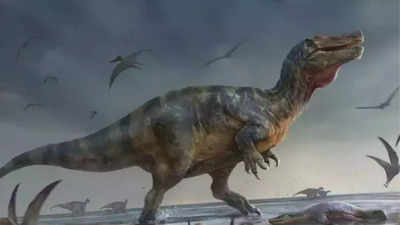- News
- Science News
- Where did dinosaurs originate? Experts trace their beginnings to ancient equatorial hotspots
Where did dinosaurs originate? Experts trace their beginnings to ancient equatorial hotspots
Scientists have made new discoveries about the origins of dinosaurs, suggesting they first emerged in dry, arid regions of Gondwana. Research published in Current Biology indicates that volcanic eruptions and climate adaptations played key roles in their evolution. Future fossil discoveries in underexplored regions like the Amazon and Congo could further redefine our understanding of dinosaur beginnings.
For a long time, the origins of dinosaurs remained a mystery in our prehistoric timeline. These massive creatures, which ruled Earth for millions of years, left fossils that continue to captivate experts and enthusiasts alike. Thanks to advanced research and new technologies, we are now closer than ever to understanding their beginnings.
Recent discoveries have provided crucial evidence, helping to piece together the puzzle of dinosaur evolution. How did the first dinosaurs emerge, and what led to their dominance? The answers may surprise you and could completely change what we know about evolution. Let’s dive into this fascinating scientific journey.
What came before the first dinosaurs?
Even though dinosaurs have fascinated scientists for years, their beginnings remain largely unknown. Among the oldest are fossils from Argentina, Brazil, and Zimbabwe which date back to 230 million years ago. However, the distinct differences between these fossils indicate that dinosaurs had already begun evolving millions of years prior to these creatures appearing.
“Dinosaurs are well studied, but we still don’t really know where they came from,” said Joel Heath of University College London – the lead author of the study. This team was able to provide new insights into one of the world’s greatest mysteries by reconstructing dinosaurs’ origins.
How dinosaurs began and rose to rule
A study conducted in recent years challenges the idea that dinosaurs first evolved in temperate climates. The evidence suggests that the first dinosaurs emerged in western Gondwana, which is contemporary dry savanna and desert, around the hottest regions of the earth.
During the late Triassic, dinosaurs were small bipedal creatures, chicken-or dog-sized, that lived alongside bigger reptiles like pseudosuchians, an ancestor of crocodiles which grew to approximately 10 meters long. For hundreds of years, dinosaurs were less important for this ecosystem.
A change was marked 201 million years ago, when enormous volcanic eruptions were a characteristic for the end of the Ordovician mass extinction, destroying dominant reptile species. This enabled dinosaurs to move and expand into Argentina, Zimbabwe, and Northern Laurasia. Over the course of 135 million years, these dinosaurs became the unrivaled top land animals on earth.
Tracing the roots and adaptations of dinosaurs
A new study reveals the secrets of how early dinosaurs came to be and how they evolved. Scientists have studied evolutionary trees and found some robust evidence for the fact that dinosaurs were born in Gondwana. One significant discovery is that silesaurids, long considered distant dinosaur cousins, are actually the closest relatives of ornithischians, a group that later would include Triceratops and stegosaurs. This fills in a gap in the fossil record because ornithischians are missing from the earliest dinosaur history.
This also indicates the adaptation of different climates that occurred in the life of dinosaurs. Early dinosaurs adapted well to warm, arid environments, such as the sauropod Brontosaurus, which remained in the warmer parts. In contrast, theropods, like T. rex, and ornithischians possibly developed body heat generation to ensure survival in the diverse climate ranges. All this gives a much clearer image of the diversification of dinosaurs over millions of years and their successful living.
Could future fossil finds change our view of dinosaurs?
Although this research provides very interesting information about the origin of dinosaurs, it still lacks the necessary fossil from regions such as the Amazon, Congo, and Sahara. Notably, these are some of the least explored areas for fossils and could still provide the answers to how dinosaurs began evolving. Thus, if the cradle for the birth of dinosaurs is indeed equatorial Gondwana, the earliest ancestors may lie hidden beneath the thick rainforest or shifting sands.
The new fossil sites being discovered by paleontologists could redefine the whole concept of how dinosaurs first appeared. The story of dinosaur origins is far from complete, and future discoveries in these underexplored regions may hold the key to answering the big questions about their beginnings.
Also Read: Scientists discover two mountains taller than Everest hidden deep within Earth
End of Article
FOLLOW US ON SOCIAL MEDIA
Hot Picks
TOP TRENDING
Explore Every Corner
Across The Globe












